Scouting And Control Of Fusarium Head Blight In Wheat And Barley
Fusarium head blight (or scab) can reduce yields in wheat from floret sterility and poor seed filling. Traces of the mould on the seeds results in downgrading. The fusarium fungus also produces toxins in wheat and barley that can be harmful to humans and livestock.
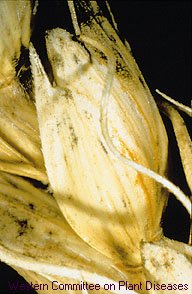
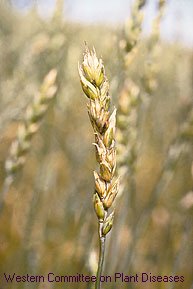
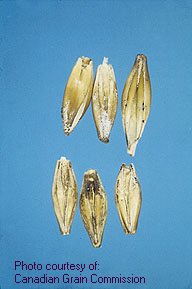
Host Crops
Wheat, barley, oats
Biology
Fusarium head blight overwinters in soil, grass and crop residue as well as in the seed. Seedlings may become infected at emergence. Spores are produced first on stem infections at the base of the plant. These spores are spread by rain or wind to infect flower parts, glumes or other portions of the head. Infections are most frequent and severe at anthesis.
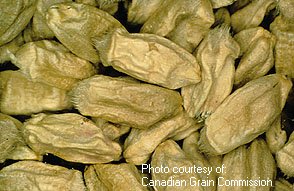
Head blight is recognized by premature bleaching of some or all of the spikelets in the head. The infected spikelets are often sterile. The seed in spikelets, above the point of infection may not develop. Diseased heads exhibit fungal growth with an orange to pinkish tinge. Infected grain is shrivelled and lighter in weight. Individual kernels are usually whitish in colour.
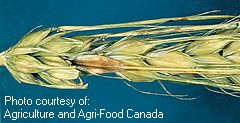
As warm, moist weather develops, spores that are spread by rain splash and wind infect the florets. Continuous moisture and warm weather (25-30 degrees C or 77-86 degrees F) are needed for infection when the grain is flowering.
Symptoms Of Damage
Blight symptoms develop within 3 days after infection if environmental conditions are favourable. Infected heads ripen prematurely. If the stem of the seed head is infected, everything above that point will be white.
Scouting Techniques
Look for a ring of pink or salmon colour at the base of the florets. Only partially-filled seeds will be found in the infected spikelets. Shrivelled grains may appear tan to white, with traces of pink on the seeds.
Economic Thresholds
None available.
Control Tips
- Although there are currently no resistant cultivars, this disease may be more severe on semi-dwarf and durum wheats than on hard red spring cultivars. Consult your provincial seed guide or agricultural representative on the best cultivars to use as there are differences between cultivars in their reaction to this disease. When harvesting, try to blow out fusarium damaged kernels since they are lighter than healthy seed.
- Follow cereal crops with broad-leaved crops. Do not seed wheat into wheat, barley, or corn stubble or into fields that are near corn fields that were infected by fusarium fungi. Turn under crop residue to reduce inoculum levels. Control barnyard grass and quackgrass because these are alternate hosts.
- Use clean seed that is free from fusarium infection. Fungicide seed treatments will protect the seedlings from seedling blight.

